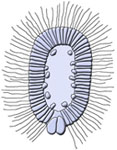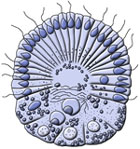Marine Biodiversity » Marine Sponges » Calcarea » Calcarea Introduction |
|
|||||
From: J.N.A. Hooper & Wiedenmayer, F. (1994): Zoological Catalogue of Australia, 12, Porifera, p. 447. with additions from the 'Sponguide'. | |||||||||||||||||||||||||||||||||||||||||||||||||||
|
The Calcarea, or calcareous sponges, have the skeleton composed exclusively of calcium carbonate spicules. The structure ranges from discrete monactinal, diactinal, triactinal or tetractinal spicules, to reticulate skeletons composed of fused crystalline calcite spicules. The distinction between megascleres and microscleres is not recognised for this class. Calcarea are always viviparous. |
|||||||||||||||||||||||||||||||||||||||||||||||||||
|
The skeleton and aquiferous system of the Calcarea occurs in three grades of construction: |
|||||||||||||||||||||||||||||||||||||||||||||||||||
|
|||||||||||||||||||||||||||||||||||||||||||||||||||
|
Calcareous sponges are most common in shallow, relatively sheltered waters (<1000 m), and are predominant in temperate regions, or in the tropics where they are mainly associated with coral reefs. Two subclasses are recognised, differentiated by larval morphology and the grade of organization of the aquiferous system. There are about 400 described species. |
|||||||||||||||||||||||||||||||||||||||||||||||||||
|
Sponges in the Subclass Calcinea have entirely ciliated hollow blastula (coeloblastula) larvae. The nuclei of their choanocytes are basinucleate, with the nuclei spherical, and the basal body of their flagellum is not adjacent to the nucleus. Most species have regular triradiate free spicules, which are equiangular and equiradiate, or exceptionally, parasagittal or sagittal triradiate spicules. Choanocytes are basinucleate; nuclei are spherical, and the basal body of the flagellum is not adjacent to the nucleus. Some species also have monactinal or diactinal free spicules as well as, or instead of, triradiates. Recent revisions are given by Borojevic & Boury-Esnault (1986) and Borojevic et al. (1990). |
 |
||||||||||||||||||||||||||||||||||||||||||||||||||
|
Sponges in the subclass Calcaronea have an incubated amphiblastula larvae, flagellated only on the anterior half. The nuclei of their choanocytes are apical, and the flagellum arises directly from the nucleus. Spicules occur here as triradiate and sagittal (two rays are paired and the third ray is longer than the others), as well as free monaxonic (monactinal or diactinal) forms. The aquiferous system ranges from asconoid to leuconoid grades of construction. Recent revison by Borojevic et al. (2000). |
 |
||||||||||||||||||||||||||||||||||||||||||||||||||